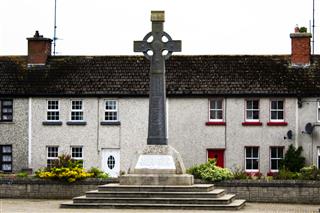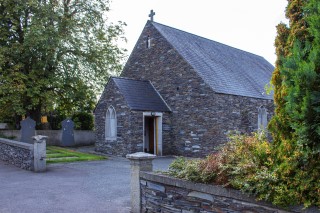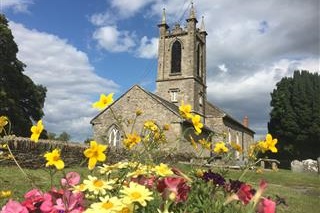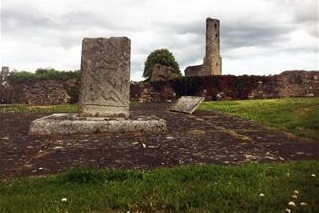Ferns Heritage Trail
Ferns Heritage Trail takes you through the heart of the historic village, where you will visit the remarkable medieval monastic remains at one end, and the imposing Norman Castle at the other. If that isn’t enough, how about a miraculous well, the grave of a famous Irish King, and the tranquil beauty of a modern-day hermitage?
FIND OUT MORE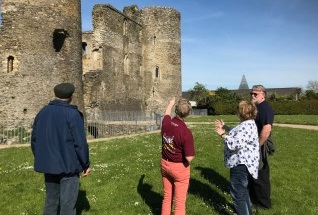
Guided Tours
Telling the story of Ferns’ medieval past, from the arrival of St. Aidan in the 6th century, through to the 12th century when Diarmait MacMurrough, King of Leinster had his royal seat in Ferns, and on to the arrival of the Normans and Strongbow…hear about some of the most famous and colourful characters in Ireland’s Ancient East.
BOOKINGS/ENQUIRYAncient Connections
Ancient Connections is a new heritage and arts project linking County Wexford in Ireland with North Pembrokeshire in Wales, specifically Ferns and St. Davids. The aim is to support rural communities and the local economy, improving the cultural offer and attracting more out-of-season overseas tourists.
FIND OUT MOREThe Ferns Conference
This annual event is organised by the Ferns Heritage Project Group. With the focus is on promoting our early Christian and medieval heritage, the annul conference promises an interesting insight into Ferns past.
FIND OUT MOREMusic
Ferns has a strong musical heritage. Across the genres, from traditional uileann pipers to showbands, music has transcended through the generations to the vibrant music scene still alive and well in Ferns today.
FIND OUT MOREAsk the Locals
Who better than a local to tell you all about the local area! A Fantastic new #AskTheLocals campaign rolled out by Wexford Trails and piloted in Ferns Village. Go beyond the guidebooks and Ask a Local!
FIND OUT MORE
Come visit, take a tour and hear the fascinating history of Ferns from the 6th to the 12th century
Human habitation in Ferns can be dated back to the Iron and Bronze ages as evidenced by archaeological works carried out. Renowned as a significant ecclesiastical settlement from the time of St. Aidan, as the Ancient Capital of Leinster in the 11th and 12 century because it was the seat of the kings of Leinster. It became the gateway to Norman Wexford because of its key role in the arrival of the Normans in 1169.
But its links to key events in Irish history didn’t stop there, the people of Ferns continued to play their part in determining Ireland’s future. The 1798 Rebellion and 1916 Rising are commemorated through monuments and graves. Fr. Murphy, a key leader in the 1798 Rebellion was born in nearby Tincurry and his partial remains are interred in the old cemetery. In more recent years, local involvement in the 1916 Rising is commemorated by a plaque on Main St.
Ferns significant medieval history goes further back to the 6th century when St. Aidan (Maeodóg, Maedoc) established a monastery which grew into a significant monastic settlement. The remnants of four high crosses in the grounds of St. Edan’s Cathedral are testament to its status.
Ferns has earned its place at the centre of Wexford’s medieval history. While the most notorious of the kings was Diarmait MacMurrough who many claim to be responsible for the Norman ‘invasion’ in 1169, the story is more complex than a simple ‘invasion’. The story of Gaelic kingship and church power play a prominent role in Ferns’ medieval story.
Day Trip to National Gallery & National Museum
on Saturday, May 6th. The Daniel Maclise painting of The Marriage of Strongbow and Aoife features prominently in a short film in the Medieval Ferns Experience, a visitor attraction located on Upper Main St., Ferns. The painting and the many artefacts found in Ferns...
Evidence of Human Settlement Going Back to the Bronze Age
Ferns significant medieval story is evidenced through archaeological digs which revealed habitation from the Bronze, Iron, Christian, through to the 13th century when the Normans left evidence of their presence.
Uniquely Ferns Iron age excavation produced the first evidence of the use of iron nails. Amber beads also discovered link Ferns to the Bronze Age (during this period, Amber trade routes were established) while the many ecclesiastical sites extend to the medieval period reflecting Ferns Christian, Gaelic kingship and Norman history. This distinguishes Ferns from other significant heritage sights such as Cashel, Glendalough or Clonmacnoise which provide evidence of just the Christian period.
Monument of the Month
The National Monuments Service (NMS) designated Ferns as ‘Monument of the Month’ for October 2012 reflecting its importance as a national heritage site. The National Monuments Service is part of the Department of Arts, Heritage and the Gaeltacht and plays a key role in the protection of our archaeological heritage.







